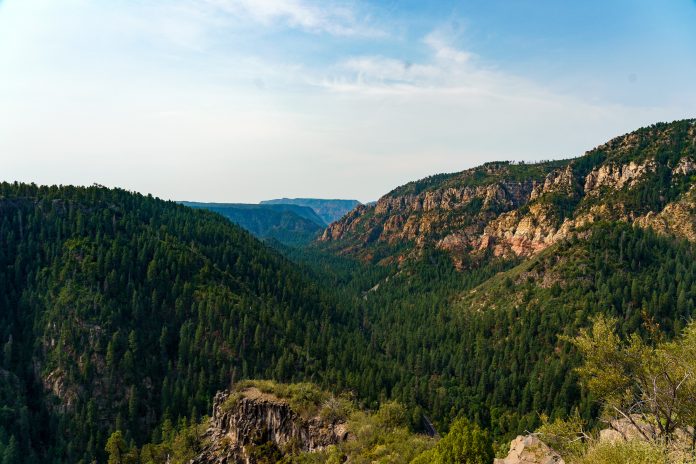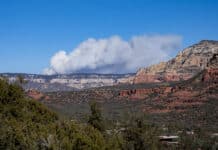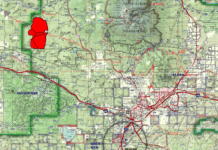
State and federal agencies have focused attention on Oak Creek Canyon in recent years, initiating several projects aimed at protecting the ecological treasure from heavy usage.
Last September, the U.S. Forest Service put a big Oak Creek watershed restoration project in motion, with improvements concentrated inside the canyon. New toilets and trash cans were added, while unauthorized parking and social trails were removed. In February, the USFS, in collaboration with Arizona State Parks and Trails, approved installation of a half-mile fence to prevent people from accessing Slide Rock State Park from the roadway pell mell.
The Arizona Department of Transportation got in on the action, too, completing a multi-pronged road and bridge improvement project last fall.
Despite the increased attention on Oak Creek Canyon, though, something not-so-beneficial slipped through the cracks: A 20-year federal ban on new mining claims on 10,000 acres of Oak Creek Canyon expired in May of 2019, leaving open the possibility of new mining claims in the canyon.
The moratorium on mining claims was put in place in 1999 to protect the outstanding biological and recreational values of the canyon.
Last year the expiration of the withdrawal didn’t get much attention, but in recent weeks the Center for Biological Diversity has been sounding the alarm, in part because a mining withdrawal near the Hassayampa River in the Prescott National Forest that expired around the same time has since received more than 20 new mining claims.
By law, prospecting activities that disturb surface resources on national forest land have to be approved by the local forest. Deidre McLaughlin, lands and minerals program manager for Coconino National Forest, said that so far the Forest Service has not been notified of any plans to prospect the canyon.
And if an individual or company were interested in staking a new claim in Oak Creek Canyon, McLaughlin said, there are several legal and administrative hurdles for claimants to clear.
“There’s like five different steps you have to go through. One is there has to be a deposit, or a valuable mineral there. You have to lay claim to it, you have to mark the corners, there’s paper work you have to submit, and an annual fee you have to pay. There’s something called the Prudent Man Rule, where [to] a prudent person, it has to be recoverable at a profit,” McLaughlin said. “It can’t just be, ‘oh I’m going to lay a claim and I’ll get to use this land.’ There’s all kinds of misconceptions out there with the public,” McLaughlin said.
And maybe more important than those hurdles, geologists don’t think there are any valuable deposits in Oak Creek Canyon — of the mineral sort at least.
“I read the mineral report, and in the mineral report , there were no known deposits,” McLaughlin said, “but it has moderate potential for uranium to exist.”
The USFS and the Bureau of Land Management , which manages the subsurface resources for all federal lands, were working on renewing the Oak Creek mining withdrawal before the expiration, but according to McLaughlin, administrative delays caused the agencies to fall behind their timeline on the renewal process.
Eventually, the BLM decided to drop the Oak Creek renewal to focus their efforts on renewing a 75,000-acre mining withdrawal in the San Francisco Peaks, set to expire October 2020, “which was one with a time frame that they knew they could meet,” McLaughlin said.
The San Francisco Peaks 20-year withdrawal is on track for renewal before expiration. Coconino National Forest is currently accepting public comments on the withdrawal through Sept. 14.
A new mining claim moratorium for Oak Creek Canyon is currently working its way through the administrative pipeline. Because the previous withdrawal expired, the USFS had to start over and submit a new proposal to BLM for another 20-year withdrawal, the maximum length allowed. An act of the U.S. Congress could permanently withdrawal Oak Creek Canyon from new mining claims.
“It’s a long process as you might imagine. It’s got two federal agencies involved and lots of review,” McLaughlin said. “The local forest fills out the application, it goes to the regional office and up to the Washington office, and then from the Washington office over to the BLM, where they review it. And there’s a lot of requirements that go with it as well. There has to be a notice in the Federal Register, there has to be public meetings, so, yeah, it’s a timely process.”
The Coconino National Forest has sent a new Oak Creek mining withdrawal proposal to USFS’ regional office in Albuquerque, where it is currently being reviewed, according to McLaughlin.





















